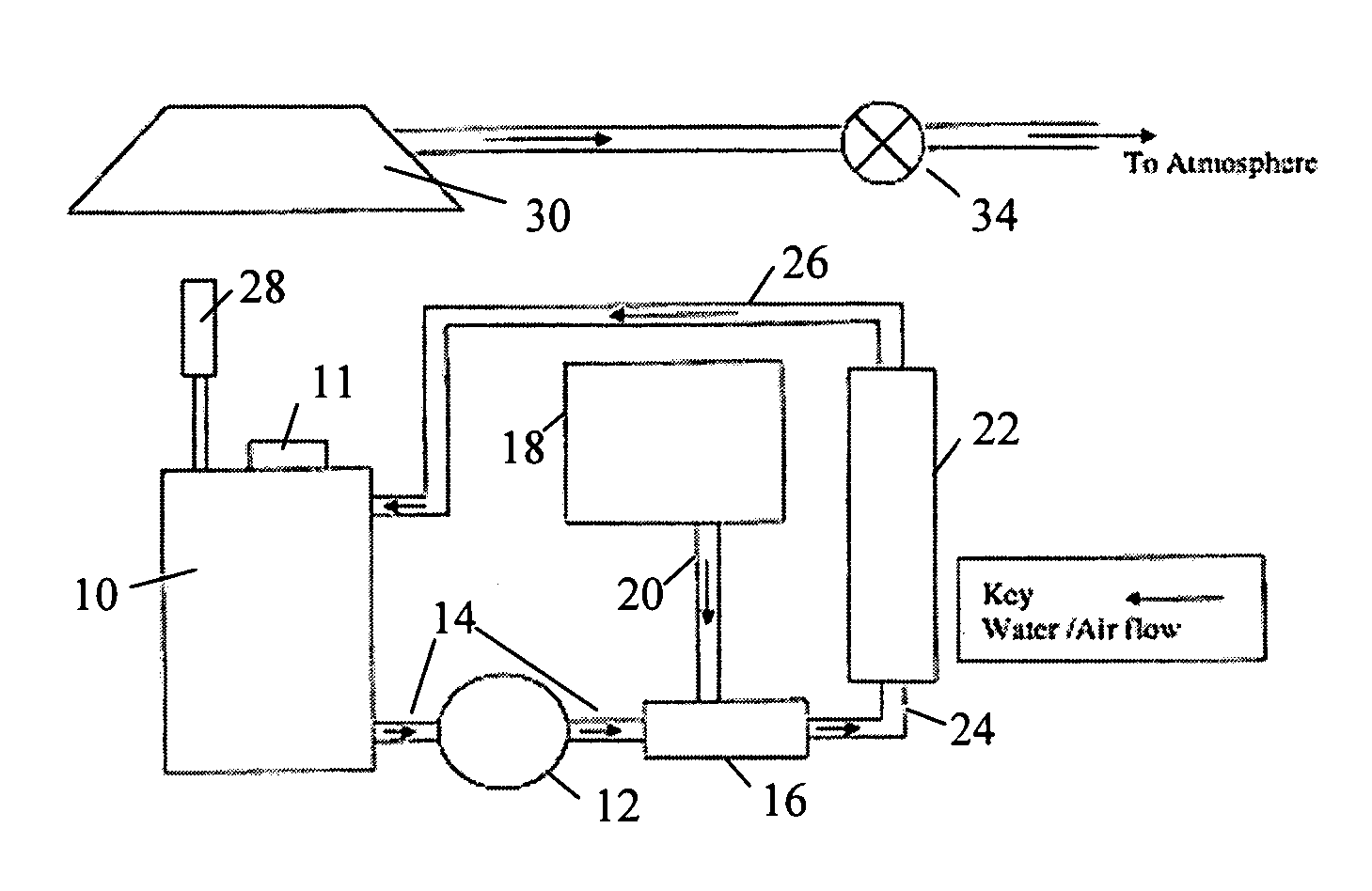Methods for recovering metals
a metal recovery and metal technology, applied in water/sewage multi-stage treatment, water/sewage treatment by oxidation, instruments, etc., can solve the problems of toxic metals from spent solutions, undesirable waste of etchant solutions, and environmental hazards of metal deposited in landfills
- Summary
- Abstract
- Description
- Claims
- Application Information
AI Technical Summary
Benefits of technology
Problems solved by technology
Method used
Image
Examples
example 1
Chemelec Cell and Spent Etchant without Initial UV / Ozone Treatment
[0038] The purpose of this experiment was to show that copper could not be recovered from a solution containing benzotriazole.
[0039] 10 liters of an etchant were made up using the following components:
TABLE 1ComponentAmountBenzotriazole 12 g / LCopper Sulfate Pentahydrate (Cu2+) 38 g / LHydrogen Peroxide (35%) 250 mLSulfuric Acid (96%) 300 mLSodium Chloride 0.5 g / LThiodiglycolic Acid0.005 g / LPolyethylene Glycol 6 g / L
[0040] A Chemelec cell was provided which was composed of a 20 liter vessel with 2 anodes composed of titanium mesh coated with ruthenium dioxide and one cathode made of stainless steel. The area of each anode was 0.26 square feet and the area of the cathode was 0.46 square feet. The cathode was placed between the two anodes. The current applied was 6 amperes and the current density for one side of the cathode was 13 A / dm2. The voltage varied from 1.60 to 1.75 volts. A rectifier supplied the electrical...
example 2
Treatment of Spent Etchant with UV and Ozone
[0045] 15 liters of an etchant having the formulation of Example 1 were placed in a holding tank of a UV / ozone unit. The UV lamp was an A4 model 254 nm, 110 W lamp. The ozone generator was an OT-005 generator obtained from Ozone Technology AB. The holding tank had a volume of 40 liters. The etchant was pumped from the holding tank by an electric pump through a conduit to a venturi where the etchant was mixed with ozone generated from an ozone generator. The ozone was introduced into the venturi at a rate of 5 gm / hour. The oxygen supplied to the ozone generator was commercial industrial oxygen (94% to 99%). The ozone was generated by corona discharge with a corona frequency on the electrode of the generator of 20 to 30 kHz. The etchant was treated for one hour with the ozone before the UV light was turned on in the UV reactor.
[0046] The UV reactor contained a centrally located UV lamp surrounded by a quartz duct with total internal reflec...
example 3
Chemelec Cell and Treated Spent Etchant
[0051] 12 liters of the treated spent etchant from Example 2 were placed into the Chemelec cell. 2 anodes were used, which were made of titanium mesh coated with ruthenium dioxide and had an area of 0.26 square feet. A cathode of stainless steel with an area of 0.46 square feet was placed between the two anodes. The current applied was 10 amperes and the current density for one side of the cathode was 22 A / dm2.
[0052] Prior to placing the electrodes in the cell with the spent etchant, the etchant was allowed to circulate for 10 minutes. An electric pump was used to circulate the etchant. After the etchant was initially stirred, the electrodes were placed into the cell and were connected to a rectifier and the current was turned on. The current was slowly increased by 1 ampere per half-hour until a maximum current of 10 amperes was reached. An analysis of the amount of copper present was carried out every 30 minutes and then every hour to deter...
PUM
| Property | Measurement | Unit |
|---|---|---|
| concentrations | aaaaa | aaaaa |
| concentrations | aaaaa | aaaaa |
| wavelength | aaaaa | aaaaa |
Abstract
Description
Claims
Application Information
 Login to View More
Login to View More - R&D
- Intellectual Property
- Life Sciences
- Materials
- Tech Scout
- Unparalleled Data Quality
- Higher Quality Content
- 60% Fewer Hallucinations
Browse by: Latest US Patents, China's latest patents, Technical Efficacy Thesaurus, Application Domain, Technology Topic, Popular Technical Reports.
© 2025 PatSnap. All rights reserved.Legal|Privacy policy|Modern Slavery Act Transparency Statement|Sitemap|About US| Contact US: help@patsnap.com


